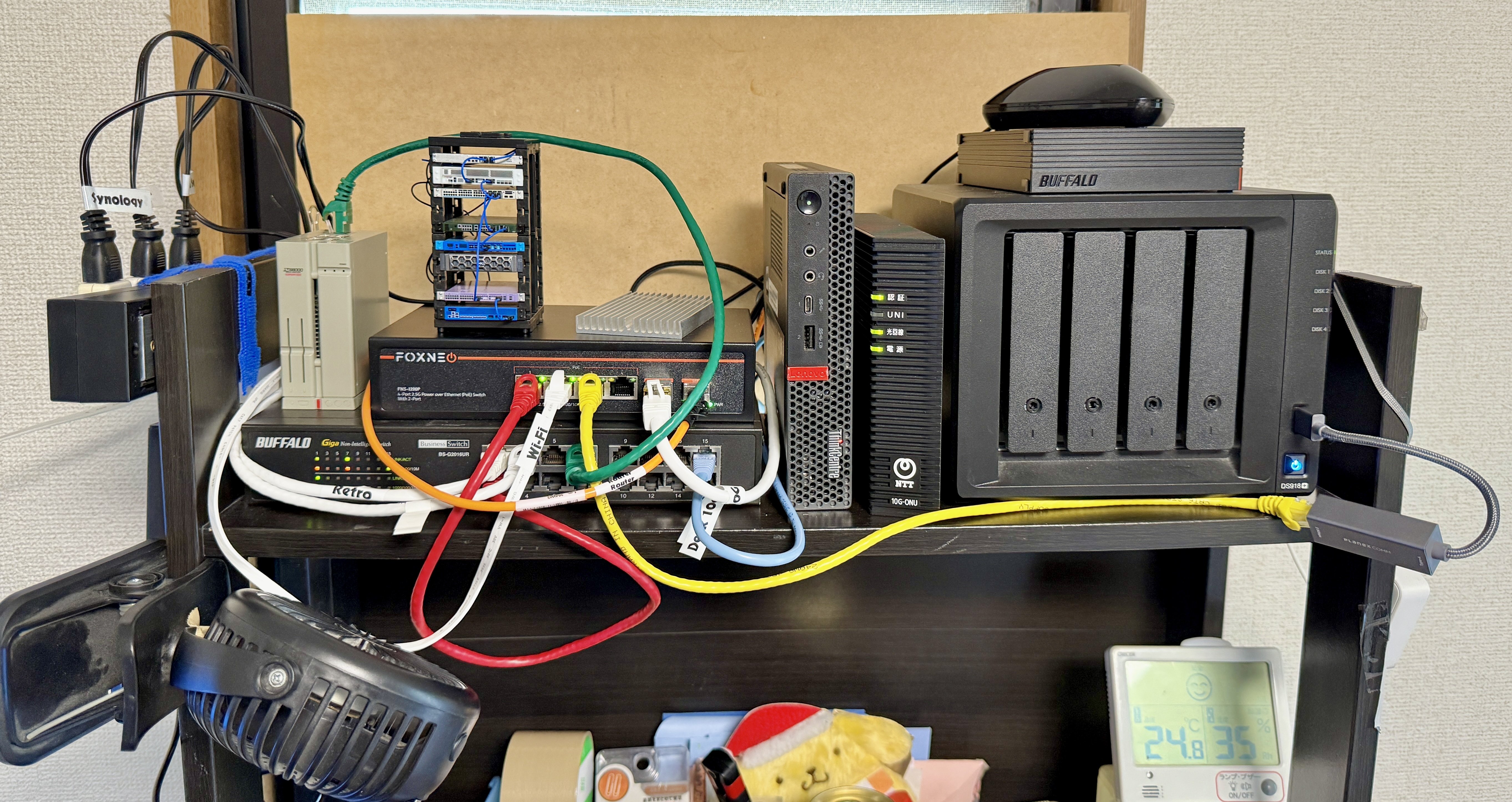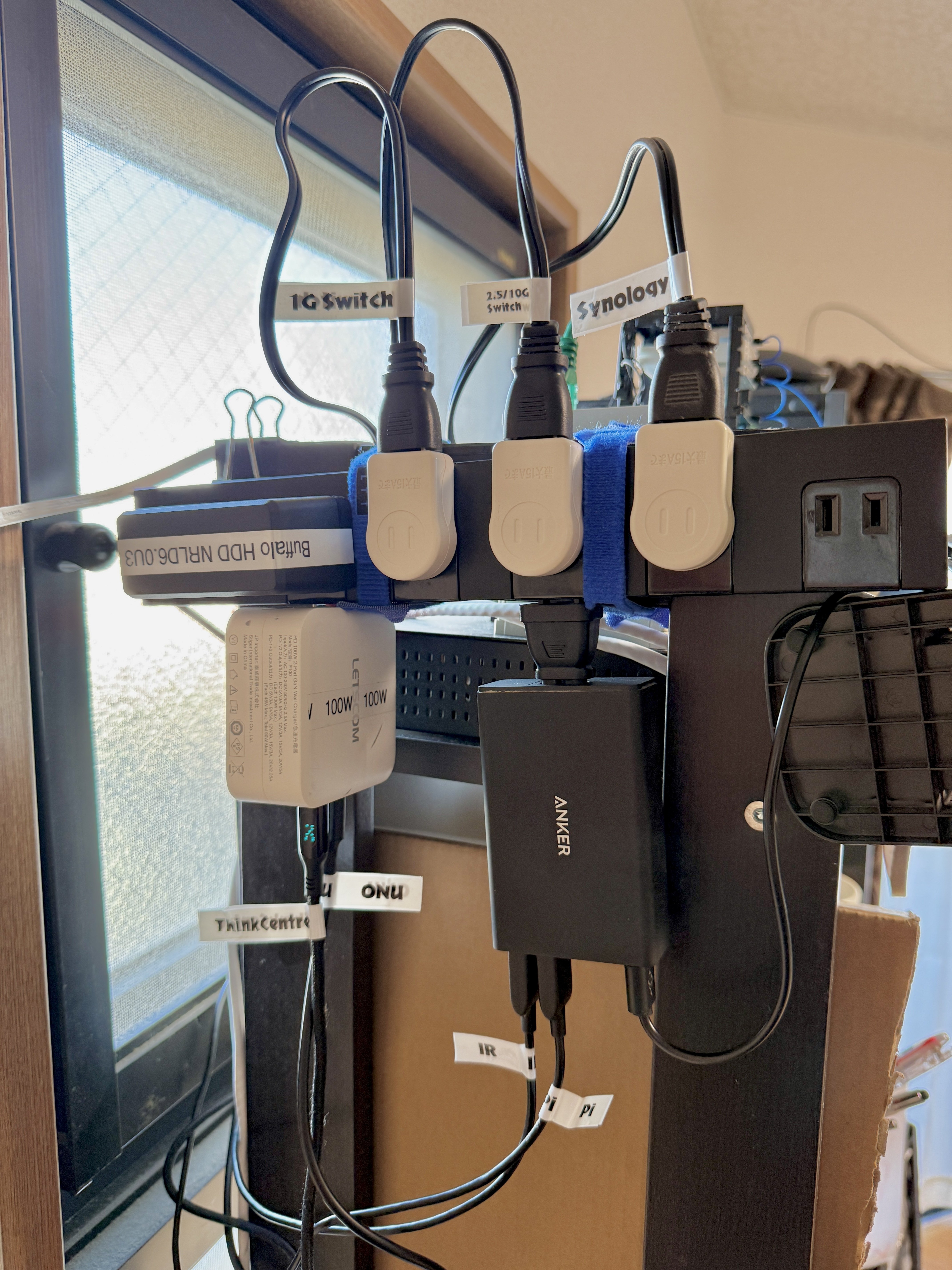It’s from a japanese Gacha machine! https://bitbang.social/@kalleboo/112755170852099746
- 1 Post
- 20 Comments
Precisely, the rear ethernet is 1 Gbit, the USB adapter is 2.5 Gbit!

 14·5 days ago
14·5 days agoI just got 10 Gbit internet last week so I had a chance to tidy everything up. The ThinkCentre is the 10 Gbit router, the Synology actually hosts everything.

Also finally labeled all the mystery cables. Also replaced the proprietary 20V/12V bricks for the ThinkCentre and 10G Fiber ONU with USB-C adapter cables to keep things tidier.


 1·7 days ago
1·7 days agoHere are some results if anyone comes across this thread in the future.
The baseline result I need to achieve is a speedtest result of 7.5 Gbit that the ISP’s rental router gives me.
I ended up picking up:
- Lenovo ThinkCentre Tiny M720q, Core i3 8100T, 8 GB RAM ($70)
- Huawei SP310 (Intel X520-DA2/82599) dual 10 Gbit NIC ($20)
- 16x PCIe riser + Network Card Bracket ($20)
Initially I installed pfSense. I ran iperf3 to just get an initial sanity check that the PCIe card/wiring was working right but was getting results between 3-7 Gbit with the CPU pegging at 50%. Some quick googling returned results like “you can’t run iperf on pfSense!” and “pfSense isn’t a router, why do people keep using it as a router, it’s a firewall!”, so I decided to switch to OpenWRT since the Linux side of things always seems to make more sense.
On OpenWRT, iperf easily hit 9 Gbit with like the CPU at 95% idle.
It took like 2 hours to configure the weird IPIP6 tunnel my ISP uses for IPv4, but once it was set up, the machine has no trouble routing the same 7.5 Gbit speedtest the ISP router managed, with the CPU usage at 78% idle (the remainder in “sirq”)
Power consumption:
- ISP router draws a solid 16W both when it’s idle and when there is 7.5 Gbit of traffic
- The M720q draws 16W when idle and up to 29W when there is 7.5Gbit of traffic. This is with two copper SFP+
- This is without tweaking any power saving options in BIOS etc

 1·10 days ago
1·10 days agoI can only look at Mikrotik gear in jealousy since they don’t have a reseller here, so all that’s available are overpriced, un-warrantied gray imports…

 1·15 days ago
1·15 days agoVery interesting, thanks for the links

 2·15 days ago
2·15 days agoThe low power consumption is one of the reasons I was attracted to the ThinkCenter M720q devices. It definitely wouldn’t be worth it if I had to build some tower PC or run a Xeon server!
The ISP router I’m getting is 10 Gbit (on WAN and one LAN port, the rest are 1 Gbit), but the configuration seems limited and it’s a $5/mo rental tacked onto the bill.
I think I can live without IDS/IPS, in all the time I used it on UniFi, it never gave me any actionable info, so hopefully that helps me with performance.
That’s interesting about the 10Gbit ethernet cards. Is that with something like a Mellanox or some other card? My NAS is going to be stuck on 2.5 Gbit since it’s just a Synology.

 4·15 days ago
4·15 days agoThanks for the Intel x520 recommendation, those are looking like a much better deal right now than the Mellanox cards I was looking at.
Glad to hear it about the BSD networking!
I’m still trying to avoid the Xeons for power consumption reasons, hehe, although it would be a lot more fun for sure!

 2·15 days ago
2·15 days agoYeah I’m not ordering anything until I have the connection up and running, which is why I opted to rent the ISP router to begin with, but looking at results online that others on the same ISP have posted, I can probably expect up to around 7 Gbit real-world so I’ve been thinking that I will at least want something better than the standard 1 Gbit or even 2.5 Gbit stuff out there, hence why I’m trying to research what the hardware requirements actually are!

 2·15 days ago
2·15 days agoThese ThinkCenter M720q machines I’m looking at all seem to have a single PCIe 3.0 8x card slot, regardless of the CPU, and that seems to be all that the Mellanox ConnectX cards need according to their spec sheets, so hopefully that is good.

 12·15 days ago
12·15 days agoWe also need to consider the practical aspects. Who mucks after the horses? Who feeds them? Do we need a stall? Does it need to be air conditioned in the summer/winter?

 1·15 days ago
1·15 days agoThe problem is that it all looks really $$$, even on the used market

 1·21 days ago
1·21 days agodeleted by creator

 7·21 days ago
7·21 days agoFor anyone who’s not in the Synology ecosystem, this is what the release notes are:
Starting from this version, the processing of media files using HEVC (H.265), AVC (H.264), and VC-1 codecs will be transitioned from the server to end devices to reduce unnecessary resource usage on the system and enhance system efficiency. These codecs are widespread on end devices such as smartphones, tablets, computers, and smart TVs. If the end device does not support the required codecs, the use of media files may be limited.
This mostly affects things like streaming to a TV, streaming box or tablet with limited codec support.
When watching videos on Linux, the support on the NAS itself doesn’t matter, just the support only your PC. When opening videos over SMB in dolphin, the codec support on the NAS does not come into play. The thumbnails are generated by your PC.
Just install VLC on your PC and it will play whatever you throw at it, regardless of OS codecs. I would not re-encode anything.
edit: It looks like the biggest impact is using Synology Photos - it can’t generate thumbnails for HEIF photos/HEIC videos anymore
The logic was just that when UNIX was originally evolving, they ran out of disk space on their PDP-11 and had to start moving less-essential binaries to a different disk. That’s why it’s “/usr/” which was originally for user data but that disk happened to have free space.
Any other explanation is just retcon. Some distros try to simplify things.
I literally said it has nothing to do with Photoshop - if you shoot a photo on your iPhone or Google Pixel it shoots in HDR, and then you just use the built-in editor on your PHONE, it will edit in HDR. Linux is worse than Pixel and iOS stock photo apps at photo editing. I don’t know why you’re obsessed with Photoshop.
This isn’t about being fancy with Photoshop layering together bracketed photos - modern flagship smartphones all shoot direct in HDR. Basic edits in stuff like Apple Photos on the Mac or Google Photos take this into account.
There was an updater for iTunes or something for MacOS X that would wipe out your home directory if your hard disk had a space in its name. The default name for the Mac hard disk from the factory is “Macintosh HD”.

It’s 6 years old now so I can’t really complain but even new ones don’t come with 2.5Gbe by standard, it seems that should be cheap enough to throw in there by now. At least a lot of the new ones can be upgraded internally to 10 Gbe.